CONTINUED FROM WOODSIDE, QUEENS PART 1
“WWRL Radio took to the air at midnight on August 26, 1926 at a frequency of 1160 AM. Blue burlap was draped over the walls of the Reuman parlor at 41-30 58th St. in Woodside, Queens, and a transmitter and antenna were installed in the backyard. The Reumans continued to live in the house, with friends and neighbors dropping by to sing, play, or announce the programs. Most of the artists were local amateurs whose appearance on WWRL would be a high spot in their careers, although Ethel Zimmerman, a singer from Astoria, would go on to superstardom as Ethel Merman.” (from NYC AM Radio History website)
WWRL continued to broadcast from Woodside until earlier this year (2005), when it relocated to Manhattan. A giant radio tower still rises into the sky at the site but the signs pictured above, taken in 2004, are now gone.
Left: The Returned Soldier in Doughboy Park. The statue honors the memory of those lost in WWI and was dedicated in 1923. “In 1928, the American Federation of Arts at Washington declared [the statue] to be the best war memorial of its kind in the United States.” (Gregory, 1994) The sculptor was Burt Johnson, who created another doughboy statue forDeWitt Clinton Park in Manhattan.
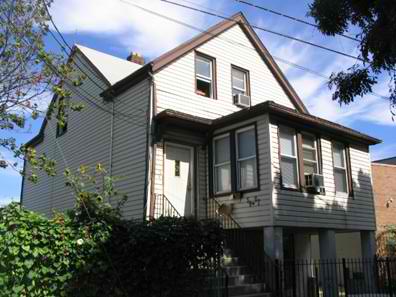 The former Moskowitz Dairy (1920 to ca. 1955) stands in the shadow of the LIRR on 38th Avenue at 54th Street. The small brick building to the right is now an industrial site, but was once where the Moskowitz’ barn stood.
The former Moskowitz Dairy (1920 to ca. 1955) stands in the shadow of the LIRR on 38th Avenue at 54th Street. The small brick building to the right is now an industrial site, but was once where the Moskowitz’ barn stood.
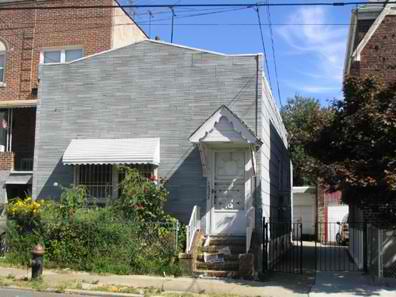 This modest one-family home was built at the turn of the 20th century on 58th Street north of Northern Boulevard. The O’Connell family owned the house, and their cows once grazed where attached homes now stand at left.
This modest one-family home was built at the turn of the 20th century on 58th Street north of Northern Boulevard. The O’Connell family owned the house, and their cows once grazed where attached homes now stand at left.
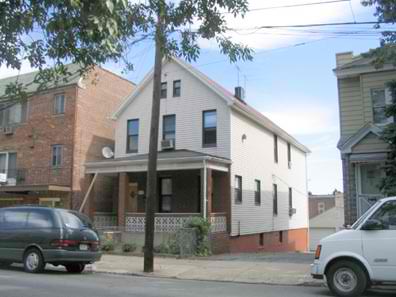 Max Sohncke sold real estate and insurance from his home-office in the first decades of the 20th century. The house originally was on Greenpoint Avenue (Roosevelt Avenue) near Betts Avenue (58th Street). When a new street was cut through, the house had to be moved to where it stands today south of Roosevelt Avenue on 57th Street.
Max Sohncke sold real estate and insurance from his home-office in the first decades of the 20th century. The house originally was on Greenpoint Avenue (Roosevelt Avenue) near Betts Avenue (58th Street). When a new street was cut through, the house had to be moved to where it stands today south of Roosevelt Avenue on 57th Street.
Sgt. Carl R. Sohncke, Max’s son, was killed in action in Europe during WWI in 1918. A square at Roosevelt Avenue and 58th Street near his home is named in his memory. He was the first Woodside resident to sacrifice his life in the war.
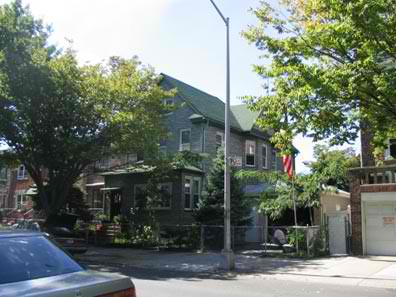 The Cornell House sat in the path of what is today Broadway. It had to be moved in order for the city to create Broadway east of 54th Street and dig the IND subway line in 1926. The house now stands on 58th Street south of 33rd Avenue.
The Cornell House sat in the path of what is today Broadway. It had to be moved in order for the city to create Broadway east of 54th Street and dig the IND subway line in 1926. The house now stands on 58th Street south of 33rd Avenue.
Many Woodside houses were either torn down or moved in the name of progress. Construction of the BQE,LIRR, IND and IRT subway lines and the creation of new streets were all projects responsible for displacement of area residents. Homes and parks were also sometimes built on top of burial grounds. It was not unusual for contractors to find old bones or Revolutionary War relics as they prepared to lay a foundation for a new house.
Woodside National Bank opened in 1926, and the following year moved into the building pictured above. In 1942, the bank was bought by Manufacturers Trust, who years later merged with Hanover Trust, forming Manufacturers-Hanover Trust in 1961. That company merged with Chemical Bank in 1992.
Chase Manhattan Bank also opened a Woodside branch in 1926 in a small building on Roosevelt Avenue. In 1996, Chase merged with Chemical Bank, took over the branch at the old Woodside National Bank location, and sold their smaller location to a competitor.
Ray’s Food Shop occupied the ground floor at the corner of Roosevelt Avenue and 61st Street in 1935. Today, the space still sells food, but as Stop Inn Restaurant. Former Vice President Al Gore “stopped inn” here during his 2000 presidential campaign.
For more Woodside restaurant history, check out FNY’s Boulevard of Death, Part 1, which features photos of a former 1930’s-era Childs Restaurant on Queens Boulevard.
Your webmaster says: Let me break in very briefly and show everyone a classic Childs Restaurant on Roosevelt Avenue just east of the LIRR Woodside station…
Childs, the first great restaurant chain of the 20th Century, erected terra cotta palaces all around town. They are still recognizable by their maritime motifs and ubiquitous seahorse ornamentation.
And now, back to our show…
At the close of WWII, Arde Bulova, of Bulova Watch Company, founded a watchmaking school for disabled veterans in Woodside. The Joseph Bulova School (above), named after Arde’s father and founder of the company, opened in 1944 on 62nd Street south of Woodside Avenue. A wheelchair basketball team was organized here in 1947, and played at the gym pictured at right.
The Arde Bulova dormitory on 61st Street was equipped with a ramp for easy wheelchair access. The school stayed open through 1993. The Church of Latter Day Saints has occupied the property since 1997. The first two buildings are in immaculate condition, but the dorm currently stands behind a chain-link fence, with its door covered in graffiti.
The Bulova Watch Company maintains offices a little north of Woodside, along the BQE adjoining the New York Connecting Railroad. A short street crossing the expressway was named for the company.
St. Sebastian’s Church was founded in 1894 at the Firemen’s Hall pictured previously. A steepled structure was built at 58th Street and Woodside Avenue in 1896 on the former site of the Kelly mansion. The church was replaced by a combination church and school building in 1926, which still stands at the site. Today, the building is used only as a school.
The current St. Sebastian’s Church opened in 1952 on the south side of Roosevelt Avenue at 58th Street in what used to be a theater called Loew’s Woodside. President Bill Clinton visited St. Sebastian in November 1998 to stump for Chuck Schumer in his successful bid to unseat incumbent Senator Al D’Amato that year.
21st Century Woodside
The walls of the bridges carrying the LIRR above the neighborhood’s streets have been beautified by artworkcommissioned by Woodside on the Move, a group orginally founded to organize the community’s celebration of the Bicentennial in 1976. One of the murals harkens back to a magical October when the Yankees and Mets fought each other for the World Series title and the World Trade Center was still standing. Another depicts an oceanic scene.
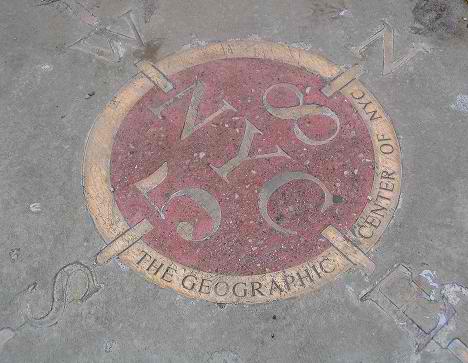 A Parks Department marker on a westbound Queens Boulevard traffic island at 58th Street declares the intersection to be the geographic center of New York. However, according to the Department of City Planning, the geographic center is in Bushwick, Brooklyn, on Stockholm Street between Wyckoff Avenue and St. Nicholas Avenue.
A Parks Department marker on a westbound Queens Boulevard traffic island at 58th Street declares the intersection to be the geographic center of New York. However, according to the Department of City Planning, the geographic center is in Bushwick, Brooklyn, on Stockholm Street between Wyckoff Avenue and St. Nicholas Avenue.
There is no dispute, however, that Woodside remains a center for the Irish- American community of Queens. Asian and Hispanic-Americans have also settled into the neighborhood in large numbers.
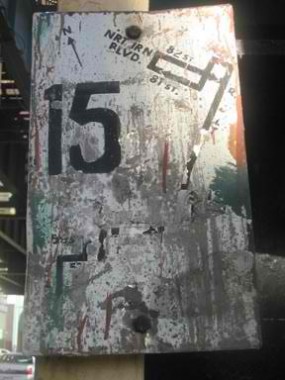 The remains of a 1960’s era bus sign on Roosevelt Avenue. What was the number 15 is now the Q32.
The remains of a 1960’s era bus sign on Roosevelt Avenue. What was the number 15 is now the Q32.
 Some things that happen in Woodside, should stay in Woodside!
Some things that happen in Woodside, should stay in Woodside!
More Woodside photos are available in my Woodside slideshow.
The black-and-white photos and bulk of the historical information that appears on this page were taken from Catherine Gregory’s book, Woodside, a Historical Perspective 1652-1994
1873 map of Woodside used as background for this page from Brooklyn Genealogy Information Page.
Modern-day Woodside Station photo from Urbahn Architects.
Jackson Social and Field Club 1903 photo from Jackson Social and Field Club.
Rabbit Maranville photo from PlayItUsa.
Sources:
Gregory, Catherine, Woodside, a Historical Perspective 1652-1994, Woodside on the Move, 1994
Seyfried, Vincent and Asedorian, William, Old Queens, N.Y. in Early Photographs, Dover Publications, 1991
Greater Astoria Historical Society
National Baseball Hall of Fame
New York City Parks Department
NYC AM Radio History
Queens Gazette
Christina and Presidential Scottie Miss Beazley get together at the White House.
The photographs for this page were taken on March 20th, 2004, August 27th, 2005 and September 11th, 24th, & 26th, 2005 and the page was completed on September 27th, 2005 by award-winning Forgotten NY correspondent, Christina Wilkinson.
Questions for Christina: nutrichris”@”rcn.com
For your webmaster: erpietri”@”earthlink.net
©2005 Midnight Fish
But that ain’t all!
Your webmaster here. I have even more Woodside images for your education and amusement.
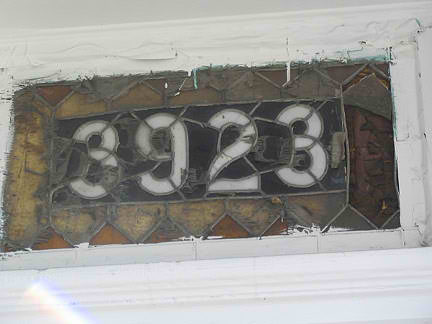 Stained-glass house number, 64th Street near 39th Avenue.
Stained-glass house number, 64th Street near 39th Avenue.
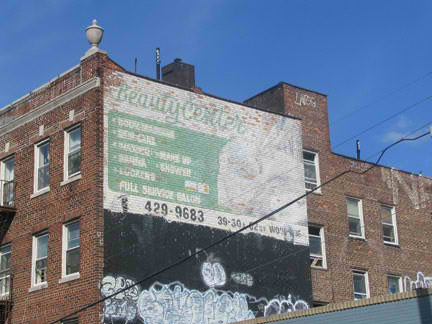 “Beauty Center” mural ad visible from 61st Street-Woodside subway platform. The beauty parlor is long gone.
“Beauty Center” mural ad visible from 61st Street-Woodside subway platform. The beauty parlor is long gone.
The Diamond Diner was in a prime spot on Roosevelt Avenue right under the LIRR overpass. Was is the correct verb.
Some very old signs. That was a few Pepsi logos ago.
Queens Court West, apartment on 39th Avenue with terra cotta ornamentation and signs.
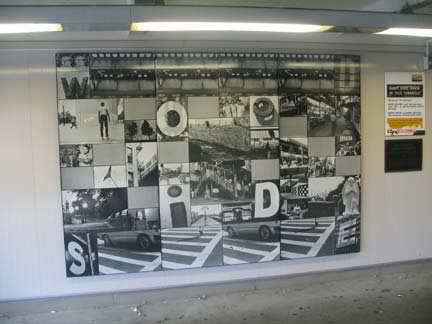 61st Street-Woodside subway station contains a pair of photo collages depicting neighborhood scenes by John Cavanaugh titled Commuting/Community. They are very early examples of subway art: they were installed in 1986.
61st Street-Woodside subway station contains a pair of photo collages depicting neighborhood scenes by John Cavanaugh titled Commuting/Community. They are very early examples of subway art: they were installed in 1986.
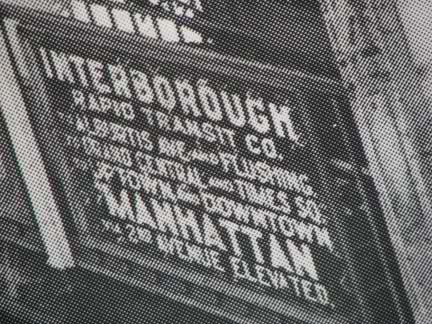 One of the murals shows an anachronism that persisted until the 1980s at one of the #7 stops: a sign advertising a connection to the 2nd Avenue Elevated, which had a spur crossing the Queensboro Bridge and joining the Flushing Line at Queensboro Plaza. The connection was severed in 1942. “Alburtis Avenue” is the former name of the 102nd Street station.
One of the murals shows an anachronism that persisted until the 1980s at one of the #7 stops: a sign advertising a connection to the 2nd Avenue Elevated, which had a spur crossing the Queensboro Bridge and joining the Flushing Line at Queensboro Plaza. The connection was severed in 1942. “Alburtis Avenue” is the former name of the 102nd Street station.
Why don’t you get one?
If you liked Woodside, you’ll like her sisters, SUNNYSIDE and WINFIELD.
Also: Bridgeandtunnelclub in Woodside.

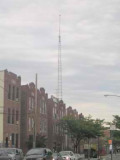
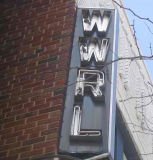
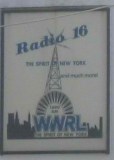

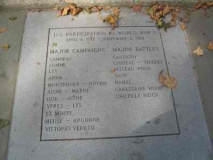
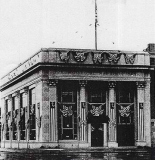
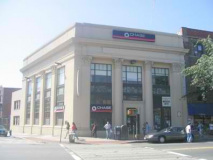
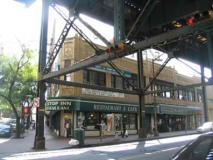
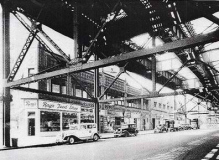
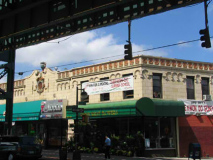
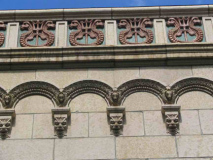
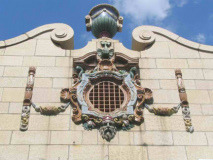
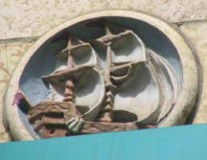

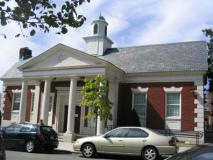
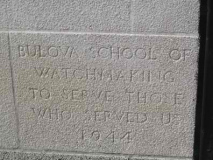
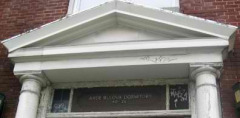
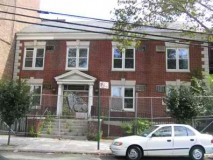
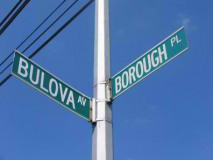
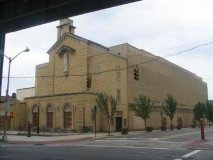
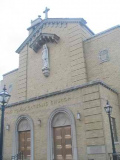
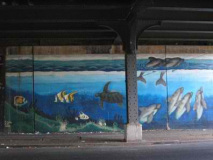
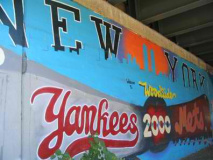


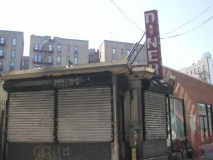
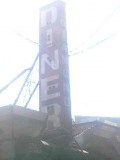
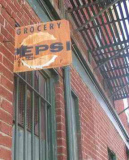
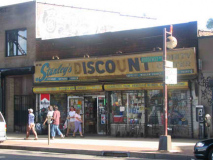
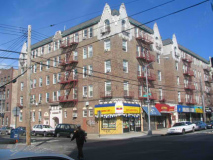
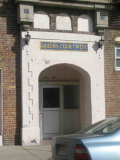

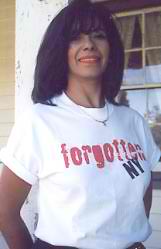
1 comment
[…] own Kevin Walsh, at his amazing Forgotten-NY site, offers that this is not the actual geographic center and opines: “according to the Department of City Planning, the geographic center is in […]
Comments are closed.